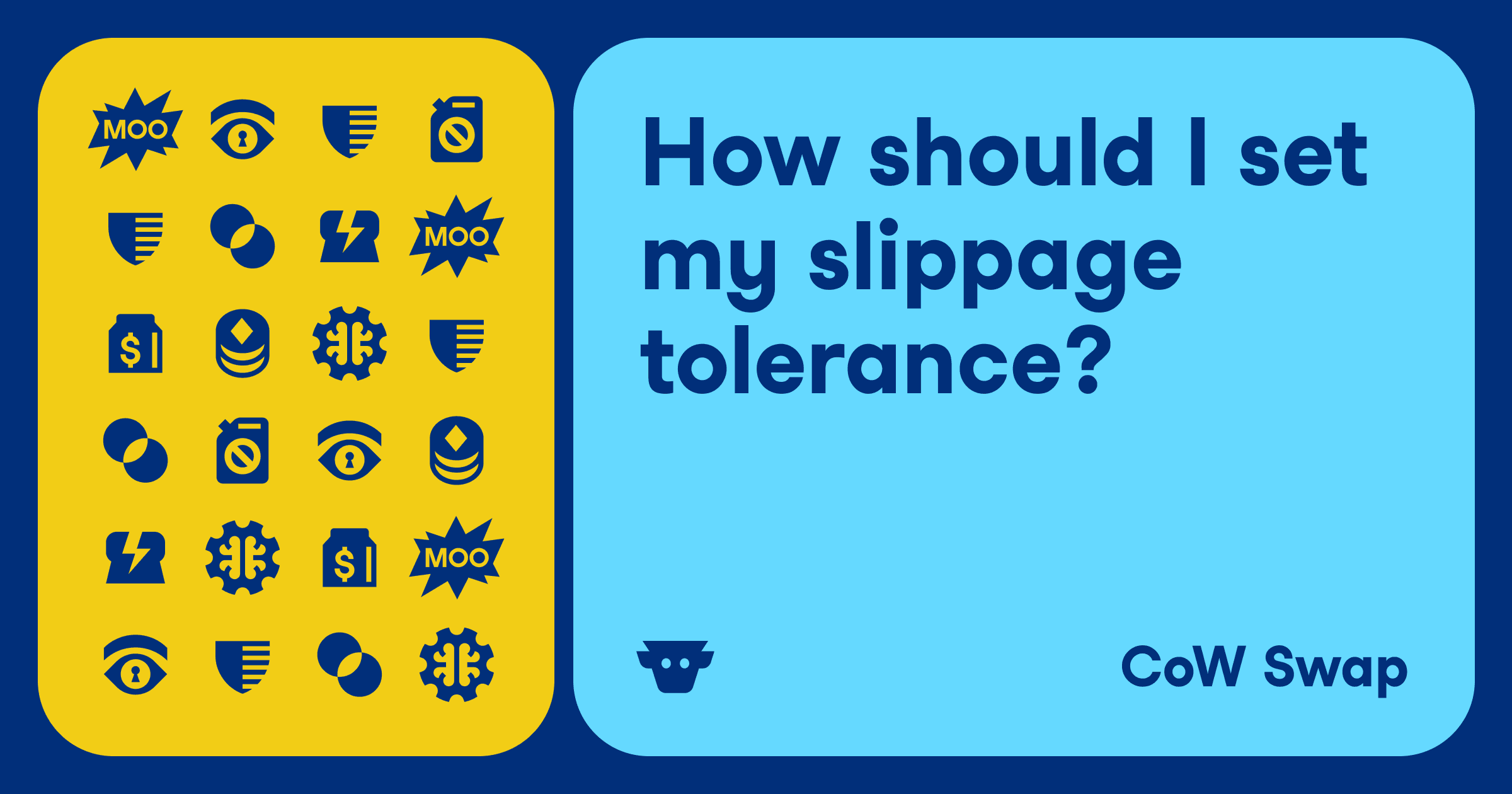Choosing a DeFi protocol
DeFi has blown open a whole new world of ways to manage your money. But with so many protocols and platforms out there, choosing where to trade isn't just another click - it's a key part of your investment strategy.
The truth is, not all protocols are built the same. The one you choose will shape your experience, your costs, and even your profits.
In this article, we'll break it down for you:
-
What DeFi protocols actually are - and why they matter
-
How to spot the right protocol for your goals
-
And how CoW Protocol helps you trade smarter, safer, and with less hassle
What is a DeFi Protocol?
A DeFi (decentralized finance) protocol is a set of rules and smart contracts on a blockchain that enables peer-to-peer financial services like lending, borrowing, and trading without a central authority like a bank.
If that flew over your head, or if you're just starting out, you can learn more with Getting Started with DeFi: Your Comprehensive Guide to Decentralized Finance.
DeFi Protocol Examples
Perhaps the most famous example of a DeFi Protocol is Aave, a decentralized lending and borrowing platform where users can lend crypto to earn interest or borrow assets without a traditional bank. Users deposit collateral into a smart contract to take out a loan, and the interest rates are determined by supply and demand within the protocol.
You also have meta-dex protocols-like CoW Protocol-that can operate across different indexes and chains, aggregating liquidity and optimizing trades for users.
Why a DeFi Protocol Matters
Your chosen protocol determines the fundamental nature of your trading experience.
Protocols offer functionality on top of the basic trading enabled by a chain. Think of this as parallel to the financial services traditionally offered by banks. For example, there are lending protocols that function just like loan services, and others that offer fund investments, indexes, and more.
Thinking About Trading Strategy and Protocols
Since different protocols offer different services, you can and should choose protocols for different aspects of your trading. You might choose one for loans, another for liquid staking, and yet another as an index.
When planning your strategy have a think about:
-
What specific tools you need for your overall trading plan?
-
What available systems are there that allow you to enact your trading plan?
-
How best does each protocol provide the tools you need and are there any downsides?
Let’s work through some of these elements.
What to Look for in a Protocol
There's more to consider than just yields or popularity. Governance structure, interoperability, fees, and community trust all play a role in how a protocol performs over time.
The following is not an exhaustive list, but these are important factors when building an understanding of the protocols you are selecting.
Protocol Liquidity
Liquidity refers to the available liquid assets in an exchange protocol used to facilitate trading.
Liquidity is generally in the form of a token associated with the protocol, and it can be user-provided or protocol-provided:
-
User-provided: Users contribute to a pool that pays out dividends from fees.
-
Protocol-provided: An established pool of liquid assets that the protocol maintains on its own balance sheets, sustained by revenue from transaction fees.
Why Liquidity Matters
When liquidity dries up, trades take longer, and the market can stagnate-a death knell for a protocol's relevance in the competitive DeFi world.
Long-term, sustainable liquidity is ideal for a baseline protocol. While you may look at less stable protocols for short-term strategies, you don't want to become over-leveraged on them.
Generally speaking, protocol-provided liquidity is more stable long-term, as long as the protocol has the backing to provide it. User-provided liquidity, on the other hand, relies on the continued interest of liquidity investors.
Trading Mechanisms
Different protocols resolve queued trades in different ways. A variety of trading mechanisms exist, each with its own advantages and disadvantages.
Impact of Trading Mechanisms
The trading mechanism impacts how your trading strategy works on the protocol. For example, common mechanisms like public mempools are highly susceptible to MEV (Maximal Extractable Value) attacks.
Public mempools display transactions before they are executed. MEV attackers leverage this face-up information to execute sandwich attacks, backrunning, and other predatory tactics.
In contrast, batch auction models like CoW Swap can mitigate MEV effectiveness. In this model, transactions are bundled into batches and auctioned off for execution solutions, with rewards for the most efficient solution.
Security and Stability
It is crucial to understand the details of how a protocol is secured and how you can protect yourself when using it. Being diligent is vital, especially if the protocol requires you to put assets into their holdings. Read more about protecting yourself in our guide to DeFi Security Explained.
Risks of Poor Security
The world has already seen many exchanges and protocols fall victim to malicious attacks or outright fraud, even high-profile ones. Look for protocols with proven track records and documented response procedures for security breaches. It's always best if the protocol lets you hold the keys to your own assets while interfacing with it, maintaining a non-custodial design.
CoW Protocol for DeFi
CoW Protocol is a meta-dex swap protocol that lets you move assets across and within chains. We leverage intent-based batch auctions to fend off MEV attacks and execute user trades as efficiently as possible. Our core Coincidence of Wants (CoW) tooling finds trade efficiencies that other protocols simply miss out on.
Here's how CoW Protocol stacks up in terms of the factors we discussed:
Liquidity
-
Aggregated Liquidity Access: CoW Protocol sources liquidity from AMMs, aggregators, and market makers to find the best prices across the DeFi ecosystem.
-
Peer-to-Peer Matching (CoW): When users' trades align, CoW Protocol enables direct swaps without external liquidity pools, dramatically improving efficiency and reducing fees.
-
No Proprietary Pools: The protocol doesn't rely on its own token reserves, maintaining neutrality and avoiding dependency on internal liquidity.
Trading Mechanisms
-
Intent-Based Batch Auctions: Users sign off-chain trade intents that are grouped and settled together, minimizing gas costs and exposure to MEV.
-
Solver Competition: This competition ensures each batch is executed by the strategy that maximizes user surplus across all liquidity sources.
-
Available Private Mempools: We provide you with direct MEV protection through access to private mempools.
Security
-
Non-Custodial Design: CoW Protocol keeps users' assets in their wallets until the trade executes, fundamentally preventing custody risk.
-
MEV Protection: Our private settlement and batched execution shield transactions from front-running and sandwich attacks. Learn more about how CoW Swap solves the MEV problem.
-
Audited and Transparent: Audited, transparent smart contracts and DAO oversight ensure security standards and community accountability remain high.
Our robust protocol features allow for complex trades to be executed securely on the CoW Swap exchange, protecting user transactions from MEV with blocker technology as well as protocol architecture.
👉 Try CoW Swap to see if the protocol is right for you.
Further reading
-
Getting Started with DeFi: Your Comprehensive Guide to Decentralized Finance
-
Understanding How Liquidity Works in DeFi: What It Is and Why It Matters to You

